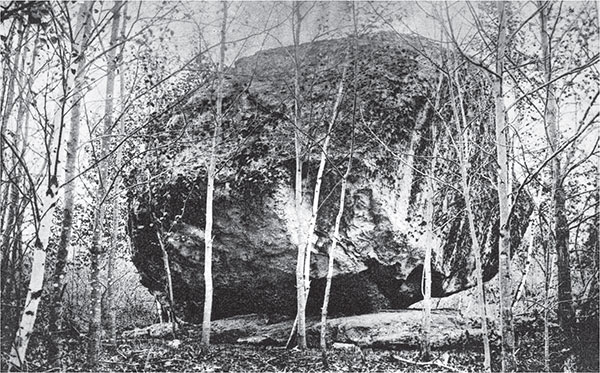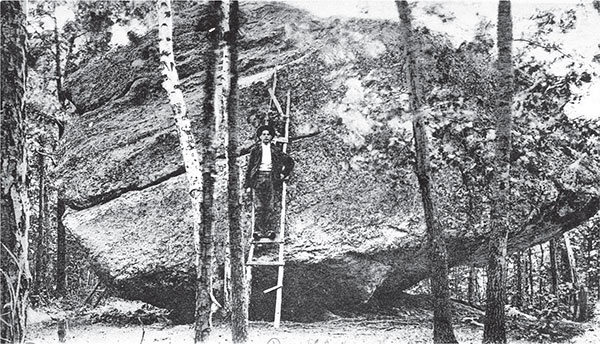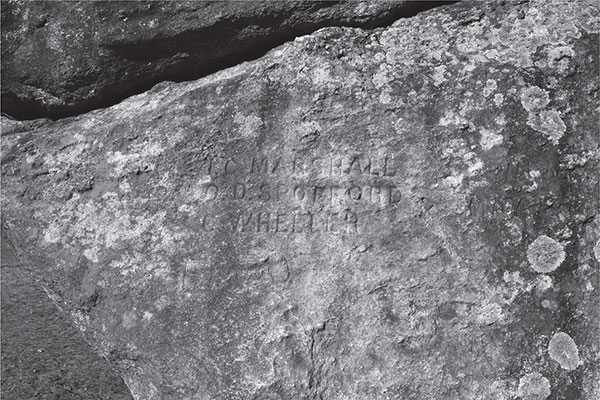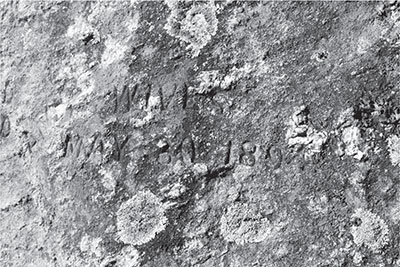
Butterfield’s Boulder as it appeared in 1883, around the time townspeople began to become interested in the massive boulder. From History of Windham in New Hampshire (Rockingham County), 1719–1883.
8
BUTTERFIELD’S BOULDER
No one is completely sure of the origin of the moniker that was given to the large glacial erratic more than a century ago, although it was certainly named for a man by the name of Butterfield. The nearly twentyfoot-high granite boulder is far different from any of the rocks in its vicinity. The rock is one of the largest freestanding boulders in New Hampshire and has rested in its current position for thousands upon thousands of years. Much can be learned about the boulder’s prehistoric history by observation. As interest in the boulder increased in the nineteenth century, townspeople began to become interested in how the unusual landmark came to be. One period observation suggested that the smoothness of the exposed cavity was likely the result of pebbles being forced against the stone by a strong current. More evidence of its ancient origins can be found in several fracture marks along the upper ledge of the boulder. These marks were made from the vast sheets of ice that spanned the entirety of the country and beyond during the glacial age. It is the glacial ice that was the driving force behind depositing the boulder where it now stands on one of Windham’s highest hills.
As for its unique shape, the Portsmouth Herald once referred to the boulder as “resembling the gigantic skull of some prehistoric monster.” Geologists who have studied the rock over the past century have arrived at the conclusion that it did not originally form near Windham and was likely originally located a significant distance away. It has also been established that the boulder has likely rested upside down for the thousands of years it has been in Windham. The evidence for this is a small “basin” on what is now the underside of the boulder. This provides ample room for curious visitors to stick their heads in and say a few words; the natural acoustic qualities provide a similar effect to speaking into “a brass kettle.”

Butterfield’s Boulder as it appeared in 1883, around the time townspeople began to become interested in the massive boulder. From History of Windham in New Hampshire (Rockingham County), 1719–1883.
Many have speculated since the nineteenth century that the rock took its name from a man from Chelmsford, Massachusetts, with the surname Butterfield. While he did not reside or own land in Windham, he did have land near the original Nutfield settlement, and there is no one else by that name in the area at the time the rock was first known by its current moniker.
However, the legend of the rock does not end with the debate over the origin of the name. Rather, the boulder gained notoriety in town due to the legend of a hunter by the name of Butterfield who used the rock as shelter on his many hunting trips in Windham.
Like much of the history of Butterfield’s Boulder, there is almost nothing known about the hunter who traversed the woods of Windham and stopped at the boulder to make his camp. The cavity under the boulder would have provided the perfect opening for the hunter to use as a shelter when night approached. Butterfield would have hunted in the early days of Windham’s settlement. This was a time when bears were common, and even if Butterfield did not intentionally seek to hunt the animal, he would have likely taken the proper precautions to ensure his night’s slumber was not interrupted by a curious bear. Another wild animal Butterfield likely would have encountered but that is no longer common is the wolf. Several of the eighteenth-century settlers noted how bothersome the wolves were, and the community would likely have been better off if Butterfield had slain one of the animals on occasion.

A souvenir postcard showing a man on a ladder against Butterfield’s Boulder. Author’s collection .

One of the late nineteenth-century inscriptions still visible on Butterfield’s Boulder. Mark Cantrell.

Inscription on Butterfield’s Boulder dated May 30, 1894. Mark Cantrell.
However, it is not the story of the hunter alone that resulted in Butterfield’s Boulder gaining in popularity. At the turn of the twentieth century, it was discovered that the top of the boulder made for a great viewing platform of the scenery around it. The top of the rock was level enough that maneuvering there would not be a precarious feat. As the boulder is about forty feet in length, it would have provided room for several people to enjoy the view from the top at the same time. In order to reach the top, a makeshift wooden ladder was often available, but this ascent was likely quite intimidating to those worried about the stability of the ladder or climbing to such a height. Those who did reach the top were rewarded with a view of Windham unlike any other.
Rather than carve one’s initials into a tree, where they would likely eventually disappear with time, several young teenagers from a century ago took the time to carve an inscription into Butterfield’s Boulder. Several young boys made the effort to carve their first initials and entire last names into the rock. As the inscriptions are still visible to this day, the boys would certainly be proud to know they left a lasting mark on Windham. There is also another easily readable inscription that is dated from May 1894. Eventually, the popularity of Butterfield’s Boulder declined, along with the popularity of other natural tourist attractions.